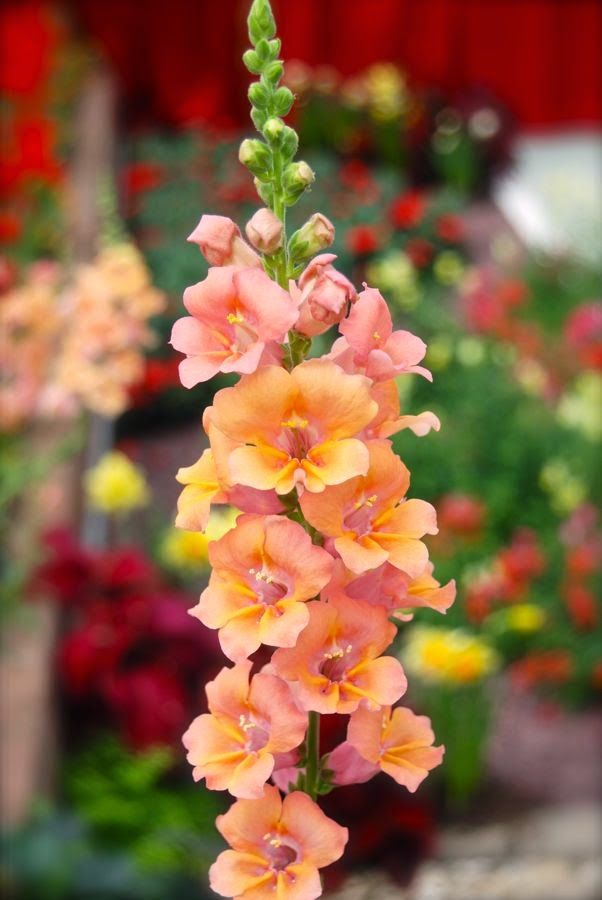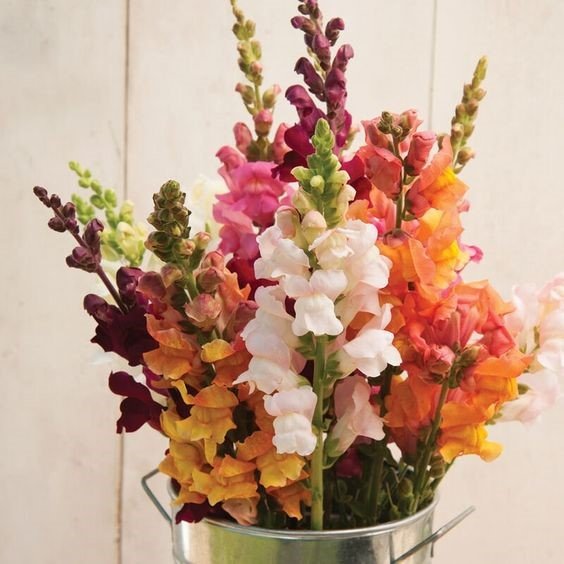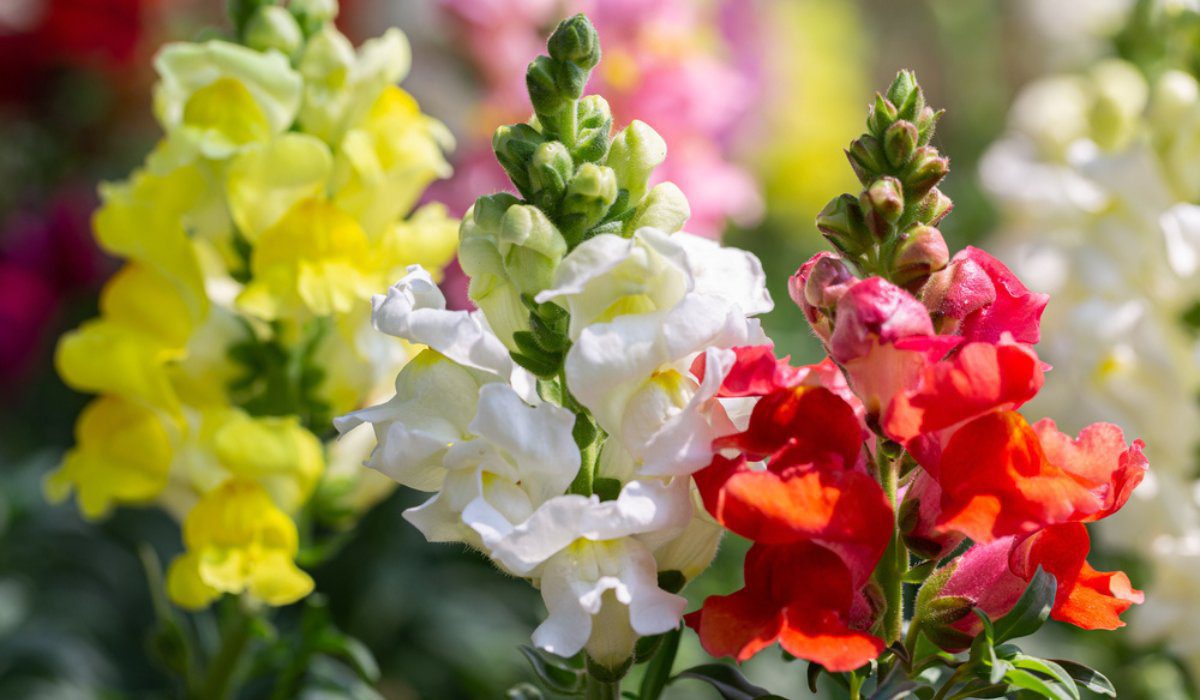The Snapdragon flower, also known as Antirrhinum, is a beautiful and unique flowering plant that is native to the Mediterranean region. This plant is a popular choice for gardeners and flower enthusiasts alike due to its vibrant colours, delicate appearance, and ease of cultivation. We will explore the different species of Snapdragon flowers and their growing conditions.
See also: Dog flower: How to grow and care for it?
Snapdragon flower: Quick facts
| Genus | Antirrhinum |
| Botanical name | Antirrhinum majus |
| Kingdom | Plantae |
| Clade | Tracheophytes |
| Family | Plantaginaceae |
| Height | 18-24 inches |
| Native | Western North America And The Western Mediterranean Region |
| Benefits | Ornamental plant, medical uses |
Snapdragon flower: Physical Description

Source: Pinterest
Snapdragon flowers come in a range of colours including white, yellow, pink, red, orange, and purple. They are characterised by their unique shape, with a narrow, tubular lower lip and an upper lip that opens wide, resembling the mouth of a dragon. The flowers grow on spikes, forming a dense spike of blooms. Each stem of a snapdragon can have multiple flowers, and the spikes can grow up to 15 cm tall. The leaves are opposite and simple, usually lanceolate in shape and typically green in colour.
Snapdragon flower: How to grow

Source: Pinterest
Seed propagation
- Add seed compost to a seed tray or pots, then lightly moisten the soil.
- The seeds should be sown on the earth’s surface and lightly dusted with additional soil.
- Keep the soil moist and put the tray or pots somewhere warm and bright.
- Once the seedlings emerge, move them to a bright but cool location until they have developed several sets of leaves.
- Plant the seedlings at a distance of 10 to 12 inches apart in the garden or in larger containers.
Cuttings propagation
- Take cuttings from healthy snapdragon plants, making sure to take a 4-6 inch cutting that includes several sets of leaves.
- Remove the lower leaves and dip the cuttings into rooting hormone powder.
- Firm up the soil around the cuttings before planting them in pots with a moist potting mix.
- Put the pots somewhere warm and sunny but out of direct sunshine.
- Keep the soil moist, and after a few weeks, the cuttings will begin to sprout new roots.
- Once the cuttings have developed a healthy root system, transplant them into larger pots or the garden.
Snapdragon flower: Maintenance tips
- Light: To ensure a beautiful display, give snapdragons plenty of sunlight but provide shade from the intense afternoon sun in warm climates.
- Soil and water: Snapdragons thrive in moist, well-draining soil and produce the most blooms under these conditions. Upon planting, water daily until they are established. Afterwards, provide one inch of water per week if there is no regular rainfall in your area.
- Temperature and humidity: Snapdragons struggle with summer heat, especially in Southern climates, and may stop blooming or even die. To prevent this, store them indoors during hot weather and replant them when cool fall nights arrive.
- Fertiliser: If you notice limited growth and fewer buds, you can rejuvenate the plants by cutting them back and applying 10-10-10 fertiliser.
- Pruning: To promote bushier growth and prevent tall snapdragons from flopping, pinch young plants back. Keep the plants deadheaded to promote continued blooming.
- Pests and problems: Space the snapdragons properly and keep the foliage dry to prevent foliar diseases such as rust and powdery mildew. If you are not growing snapdragons for cut flowers, pinch back the taller varieties to prevent them from flopping over.
Snapdragon flower: Uses
- Ornamental purposes: Snapdragon flowers are widely used as ornamental plants in gardens, parks, and indoor arrangements due to their attractive appearance and long blooming period.
- Cut flowers: The stems of snapdragon flowers are often cut and used in floral arrangements, adding colour and texture to bouquets and centrepieces.
- Medicinal uses: In traditional medicine, snapdragon flowers have been used to treat various ailments such as colds, coughs, and fevers. They contain antioxidants and anti-inflammatory compounds that help in reducing inflammation and boost immunity.
- Culinary uses: Snapdragon flowers are edible and can be used in salads and other dishes for flavour and decoration. They have a mild, sweet flavour and add a pop of colour to any dish.
FAQs
What is the ideal growing environment for Snapdragon flowers?
Snapdragon flowers grow best in moist, well-draining soil and in full sun to partial shade. It is important to provide shelter from the hot afternoon sun in warmer climates.
How can I prevent foliar diseases in Snapdragon flowers?
Make sure to space snapdragons properly and keep the foliage dry to prevent foliar diseases like rust and powdery mildew.
Can I plant snapdragon if I have pets at home?
Yes, you can, since snapdragons are not toxic to pets.
| Got any questions or point of view on our article? We would love to hear from you.
Write to our Editor-in-Chief Jhumur Ghosh at [email protected] |
Housing News Desk is the news desk of leading online real estate portal, Housing.com. Housing News Desk focuses on a variety of topics such as real estate laws, taxes, current news, property trends, home loans, rentals, décor, green homes, home improvement, etc. The main objective of the news desk, is to cover the real estate sector from the perspective of providing information that is useful to the end-user.
Facebook: https://www.facebook.com/housing.com/
Twitter: https://twitter.com/Housing
Email: [email protected]











